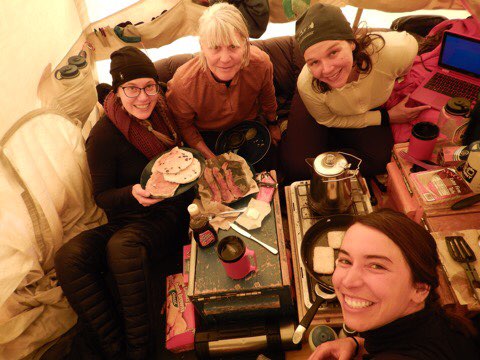There are two ways that humans get rocks from space: (1) Natural delivery of space rocks as meteorites (2) Space rocks directly brought back by space exploration missions known as returned samples.
Probably the most famous example of how humans acquired rocks from space is when the Apollo astronauts collected...
News
All week we have been riding our snow machines in a line - aka doing sweeps - over the blue ice and finding 20 or so meteorites a day. Johnny is predicting that we have about two days left of sweeps to finish a major blue ice area of...
Before they were known to be from Mars, the Martian meteorites were affectionately called the "SNC" meteorites, often pronounced "Snicks". The name comes from three specimens- Shergotty, which fell in India in 1865; Nakhla, which fell in Egypt in 1911, and Chassigny, which fell in France in 1815. They...
Today, we found 25 meteorites! Most of them are similar looking, but a few stand out from the rest. In this blog, I will explain the different types of meteorites that we find in Antarctica, and all over Earth. There are two main types of meteorites, and it’s all...
How do you prepare for the things you don’t know? That’s right - it’s tricky. And it’s one of the fundamental problems of space flight. With projects like the International Space Station (ISS), in 20 years of operation, we have gained a knowledge base that is large enough to...
ANSMET searches for meteorites are always associated with blue ice. Ice is an amazingly transformable substance. If you make it in your freezer at home, it is white and brittle. But if you take a lot of it and stack it up hundreds of feet thick, as a glacier, it...
Our Davis Ward camp site has endured two days in a row of bad weather - 30 mile per hour wind, blowing snow, and overcast skies. These conditions make it extremely difficult to search for meteorites (we need the sun to better illuminate the shiny fusion crust on meteorite...
The beginning of 2020 brought great weather for meteorite hunting to the Davis Ward ANSMET field camp. For the past 6 days, the skies have been clear, the temperatures mild (-5 to 5 degrees F) and the winds light, giving us the opportunity to engage in systematic searches on...
Boy am I good at finding “meteorWRONGS”. These are boring old Earth rocks (sorry geologists...) that look like meteorites. We identify meteorites based on their black color, glassy shiny surface (fusion crust that formed when they entered Earth’s atmosphere), and rounded shape. Common meteorwrongs we find around Davis Ward...
We’ve had two more successful days out hunting for meteorites; our total count is now up to 114! Systematically searching a blue ice field by snow machine is great fun because we come across lots of larger meteorites. Pictured here is our largest yet found, estimated to be about...










